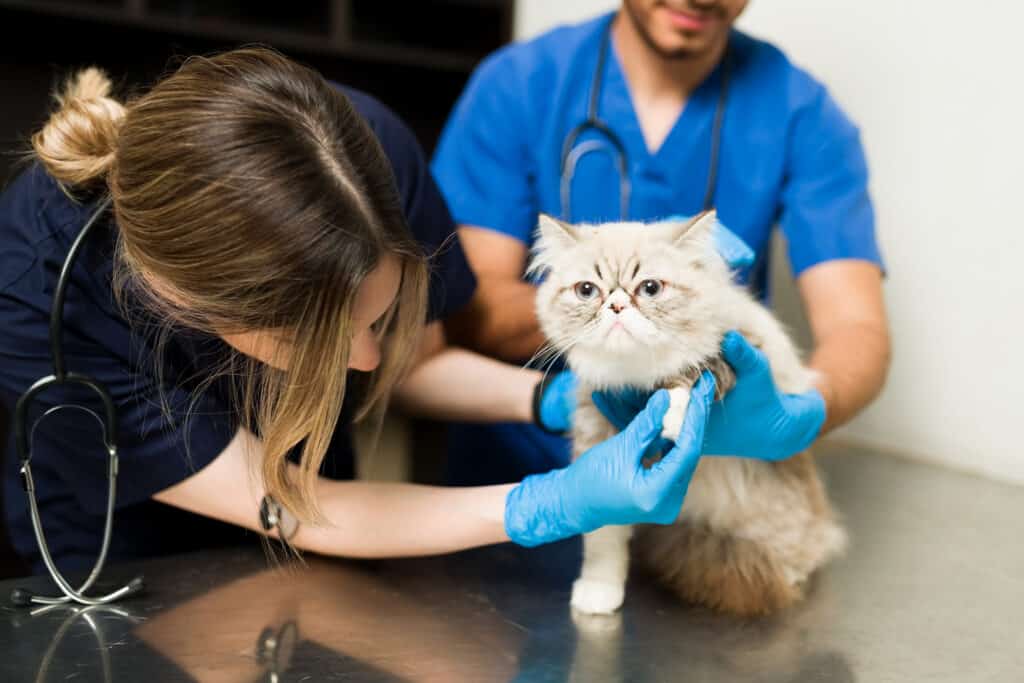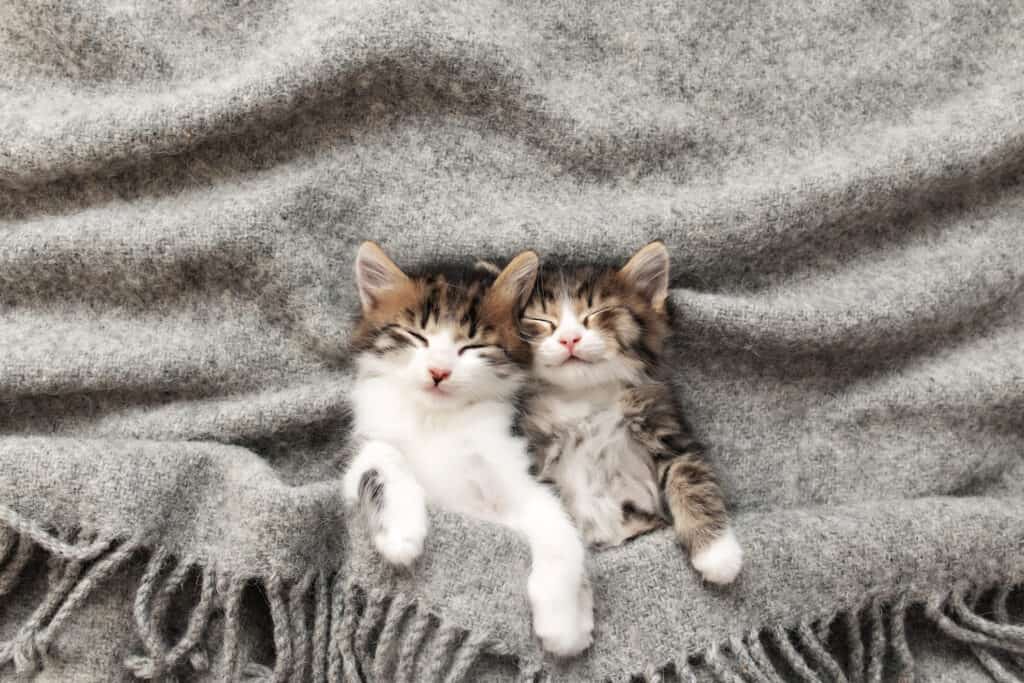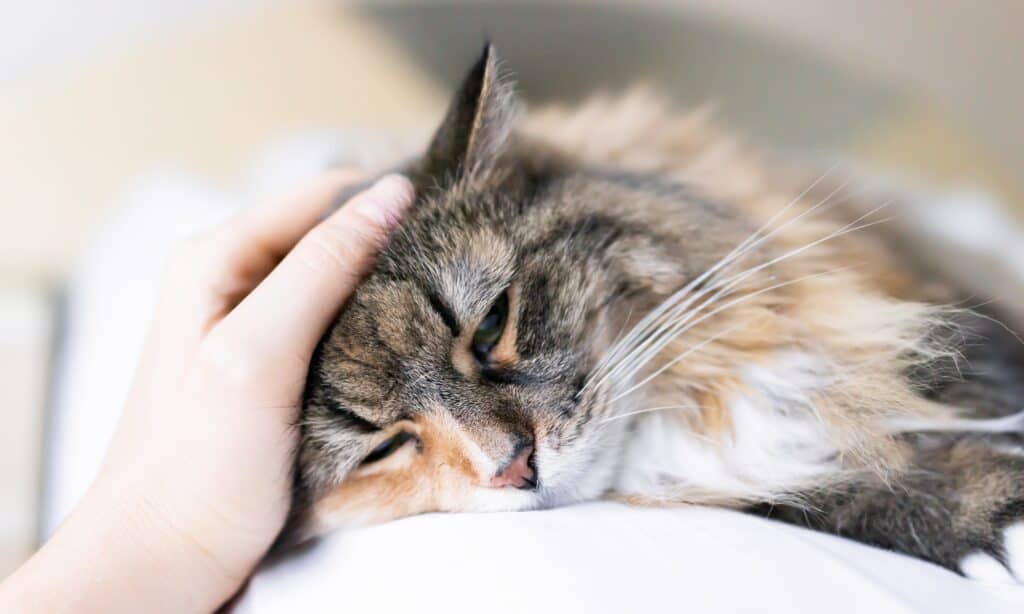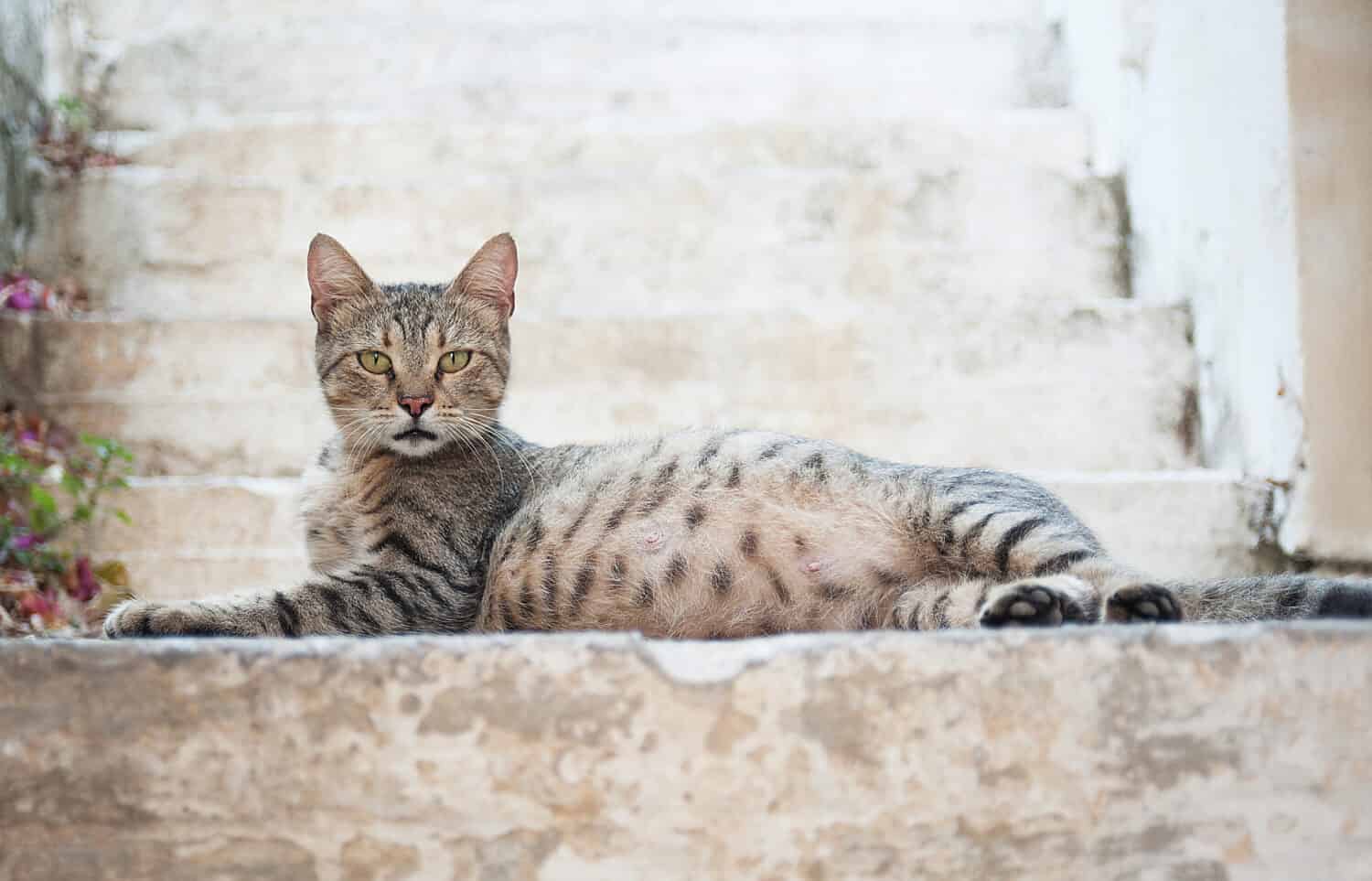Although there are many options out there, Gabapentin is one of the more popular for those suffering from seizures. Medical professionals also provide this for nerve pain, shingles, and restless leg syndrome.
It has an impact on the nerves and chemical messengers in the brain. The anticonvulsant medicine class includes the medication gabapentin. Gabapentin may be the ideal prescription for helping your feline friend feel better if they are experiencing persistent pain, tension, or anxiety disorders.
Throughout several years, vets and pet parents have been able to treat a number of illnesses with the safe and efficient use of this medication on cats. Today we’re going to be looking at how this drug, mostly given to humans, can help our feline friends!
We’ll discuss the types of gabapentin, the side effects that are possible, and the proper dosage.
Types of Gabapentin

Gabapentin is available in multiple forms.
©luchschenF/Shutterstock.com
There are four main types of Gabapentin. These are:
- Neurontin
- Gralise
- Horizant
- Generic
Neurontin: People can find relief from shingles-related pain, also known as, post-herpetic nerve pain by using Neurontin (gabapentin). For partial onset seizures among individuals who are three years of age and older, it additionally serves alongside other anti-seizure medications.
Gralise (gabapentin): Vets and doctors only prescribe this for postherpetic nerve pain, which develops after getting shingles. One should not take this medication to treat any other medical issue.
Horizant: An extended-release medication called Horizant (gabapentin enacarbil) is prescribed for the treatment of shingles-related discomfort and restless legs syndrome.
Generic Gabapentin: A decor may prescribe USP, which are generic brands of this drug, to individuals who are three years of age and older for post-herpetic neuralgia and as an adjunctive treatment for partial-onset seizures.
How Does Gabapentin Work?
The way that gabapentin reduces pain is by blocking specific brain receptors that convey pain signals to the brain and body. Your cat experiences less pain as a result, which also lowers its stress levels.
When used correctly, gabapentin is a safe drug for felines with few negative side effects. Cats who take gabapentin frequently experience minor drowsiness or lethargy as a side effect, but this usually passes after some time.
When Does a Cat Need Gabapentin?

Gabapentin is a drug that many vets swear by.
©Beach Creatives/Shutterstock.com
Gabapentin is a very safe and effective drug for cats that suffer from chronic pain or anxiety-related conditions. Although gabapentin is excellent at treating chronic pain, it is also excellent at treating neuropathic pain.
Spinal conditions in cats can cause nerve pain. Intervertebral disc disease and feline hyperesthesia syndrome both have a neurological foundation. Cats may feel more at ease as a result of gabapentin’s ability to help them feel less anxious. This is particularly pertinent when fear is the mediator of their anxious behaviors.
For example, just about every human feels fear around flying. It’s safe to say that your cat does too. If you have a trip coming up where Garfield is tagging along, asking your vet about gabapentin to ease any fears the cat may have can be useful.
Giving gabapentin to cats before frightening events, including veterinarian visits, car rides, or moving to a new home, can be very helpful because it reduces the cats’ capacity to understand fear.
Side Effects of Gabapentin on Cats
Like with anything, it’s essential to know the possible side effects that come with taking a prescription. Because the side effects are dosage-dependent, utilizing a greater dose will raise their likelihood and intensity.
This is one of the medications cats tolerate well. Because of this, side effects are relatively uncommon. Owners of pets should be aware of a few negative effects before getting a prescription, though. The following are some of the more typical side effects:
Excessive Sleeping

Cats sleep an average of 15 hours a day.
©iStock.com/Olena Ivanova
It may be surprising to learn that your cat is capable of sleeping more than they already do. Even so, you could find that your cat is sleeping more frequently than usual while taking this medication.
Cats already spend a lot of time sleeping, however when taking gabapentin you can notice your cat is less active. Recognize that if your pet sleeps a lot, it can be a side effect of the drug. If for any reason you start to get worried about this, please contact your vet.
Loss of Balance
Shaking is another typical side effect of gabapentin for pets. When using gabapentin, animals, particularly cats, frequently experience some trembling. Owners of cats must keep a watch on them in order to ensure sure they don’t become unsteady while walking.
Fatigue
Sedation is among the most prevalent side effects of gabapentin in felines. When taking gabapentin, feelings of tiredness and drowsiness cats will sometimes feel extremely tired and low-energy. The cat’s response to the medication generally determines the degree of sleepiness. Cats can respond differently to gabapentin, just as different individuals respond uniquely to various drugs.
Nausea

A couple of side effects of gabapentin are nausea and vomiting.
©iStock.com/krblokhin
Cats taking gabapentin may also experience nausea and vomiting. Although not all felines using gabapentin will throw up, pet owners should monitor their cats and notify their veterinarians if any negative effects occur.
Diarrhea
Gabapentin side effects are common, and cat owners may notice that their cats experience diarrhea after taking the medication. Cats need to have access to a clean litter box when ingesting this medication, therefore pet parents ought to be sure that they do at all times.
As your cat becomes used to gabapentin, these symptoms will pass temporarily and get better over time. Gabapentin may occasionally cause vomiting. However, this side effect is frequently not harmful and goes away fast if your cat stops taking the medication.
When Is Gabapentin Not an Option for Cats?

Cats are pregnant for 63 to 65 days.
©Jim Polakis/Shutterstock.com
Many professionals believe certain cats are safe when using gabapentin, yet the medication isn’t ideal for every feline. Only administer this medication to cats that have liver or kidney problems, sensitivities, or allergies with a veterinarian’s advice. Additionally, one should not give pregnant cats gabapentin.
Gabapentin may interact with specific medications, including morphine, antacids, hydrocodone, and other NSAIDs. Before administering the drug concurrently with other medications, get your veterinarian’s guidance.
Gabapentin Dosage Chart for Cats
Below, you’ll find a display chart for a low dose of this drug for safety reasons for cats. Before administering any medication to an elderly or ill cat or a newborn kitten, make an appointment with your veterinarian.
| Cat Size in Pounds | Dosage for Seizures | Dosage for Pain | Dosage for Sedation |
|---|---|---|---|
| 4 pounds | 10mg to 20mg | 2mg to 4mg | 20 to 40mg |
| 7 pounds | 15mg to 30mg | 3mg to 6mg | 30 to 50mg |
| 9 pounds | 20mg to 40mg | 4mg to 8mg | 50 to 75mg |
| 11 pounds | 25mg to 50mg | 5mg to 10mg | 50 to 75mg |
| 13 pounds | 30mg to 60mg | 6mg to 12mg | 50 to 75mg |
Alternatives to Gabapentin for Cats
If Gabapentin isn’t a good match for your feline friend, don’t worry! There are plenty of options out there that could work! Ask your vet about the following medications.
Benadryl

Children’s Benadryl has the active ingredient Diphenhydramine HCl and is great for cats 12 pounds and under.
©H‑E‑B, LP – License
Diphenhydramine (Benadryl) is the sole over-the-counter remedy that is frequently used to treat anxiety in cats. Benadryl is only effective for transient anxiety disorders such as anxiety related to travel. Consult your veterinarian before giving your cat diphenhydramine for nervousness or anxiety.
It might be challenging to administer human medications to pets, so it’s crucial to make sure your calculations and measurements are accurate. Generally, cats will consume one mg of diphenhydramine for every pound they weigh. Therefore, your cat will require 12mg of diphenhydramine if it weighs 12 pounds.
CBD
Cannabidiol, or CBD, has many benefits for felines, including the ability to relax and help with movement concerns. Major research on the security or effectiveness of CBD for cat anxiety has not yet been conducted. Yet, there are some studies that can help educate pet owners.
Nevertheless, numerous pet owners along with certain veterinarians have had success treating cats’ pain, nervousness, and hunger problems with CBD and THC compounds from the cannabis plant. It’s available in oils, topicals, and even cat treats!
It is best to introduce CBD to your cat with the guidance of a vet. Your veterinarian is the best source of advice for dosage, duration, and which products to try. To achieve the greatest outcomes, it will be crucial to monitor your pet and collaborate with your veterinarian.
Tramadol
In felines, tramadol is administered to treat both acute and persistent pain. Chronic osteoarthritis (OA) pain, pain from surgery, and pain brought on by trauma or illness are among the conditions that can be relieved from this drug.
Tramadol for cats generally tastes too bitter for cats to accept, therefore a liquid solution would be preferable. It is pleasant and can be blended with gravy-like treats or cat food. The medication is injected into the mouth with an oral syringe that has been loaded with the appropriate dose.
Buprenorphine
In the context of a medical facility, this opioid analgesic serves to manage pain. It’s also used as a pre-anesthetic. In the field of veterinary medicine, many medications, including this one, are frequently prescribed for off-label uses.
In these situations, carefully adhere to your veterinarian’s instructions and warnings as they may change dramatically compared to the ones on the label. Buprenorphine is administered orally as a liquid.
In order to allow it to be absorbed via the mouth, it should not be consumed, instead, it should be squirted into the inside of the cheek pouch or beneath the tongue.
A Note on Prescriptions for Your Pet
It’s important to include a note about aspirin and acetaminophen in this post. These medications should never be administered to cats for the purpose of controlling their pain without your veterinarian’s approval.
There are certain uses for aspirin in cats, however, they are very different from human usage in terms of dosage potency and dosing interval. Both acetaminophen and aspirin carry the risk of poisoning cats. Each of these medicines has toxicities that can be lethal.
Knowing that cats experience pain in a similar way to people and being able to spot your cat’s signals of pain will help you decide whether or not your cat needs pain medication. Giving your cat adequate and comprehensive pain relief will not only increase his comfort but also enable him to heal more quickly and maintain his health.
Conclusion
Cats with chronic pain or anxiety disorders can benefit from the safe and efficient treatment Gabapentin offers. Numerous instances where it has been tried effectively to lessen the symptoms of various disorders have led to improvements in the quality of life for those who utilized it.
Gabapentin won’t relieve every kind of discomfort or anxiety, thus it is best used under a veterinarian’s supervision. Mild drowsiness is the most typical side effect of gabapentin in felines, however, this typically goes away with continuing treatment.
Please speak with a vet to see whether gabapentin is the best choice for your cat if you’re thinking about giving it to them. Lastly, please note, do NOT give your cat a human form of gabapentin. It can contain a toxic substance called Xylitol.
The photo featured at the top of this post is © Sheila Fitzgerald/Shutterstock.com
Thank you for reading! Have some feedback for us? Contact the AZ Animals editorial team.






